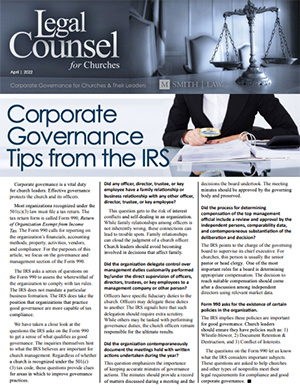One of the signs that an organization is ripe for underperformance is the stagnation of its board. A healthy board accepts the idea that rotation of its directors is good for its growth. In this article, we will explore why turnover can be an important governance strategy.
All organizations go through turnover of its officers. People leave for various reasons. In some instances, officers leave for voluntary choices. There are also occasions when board members and officers are forced to move on.
High-performing organizations recognize the inevitability of board and officer turnover. These leading companies understand change is inescapable. Consequently, proactive boards prepare for the turnover of directors.
If turnover is unavoidable, organizations should seek a systemic way to make change manageable. Turnover can be an opportunity to make the church ministry more effective. Handled badly, turnover can lead to disruption and inefficiency.
An argument can be made for turnover on a regular basis. For churches that are governed by a board, rotations can be good for the members and the body.
Some organizations mandate turnover among officer positions by enforcing term limits. Individuals who serve in governance roles may only do so for a limited time. The time is defined in years or number of terms. When the time expires, the officer relinquishes the seat and give someone else an opportunity to serve.
Forced term limits is not the only way to schedule regular board rotations. In some cases, directors reach a voluntary consensus among themselves to serve in certain capacities for a limited time. The orderly transfer of power sets a good example for succeeding leaders.
Boards that have a long-time presiding officer can appear stifling to fellow directors. Board members who don’t see a path to leadership can become complacent. The drive to continually hone one’s leadership skills may seem futile to individuals who have little opportunity to advance in the leadership ranks.
Some boards have a policy that the chairman may occupy the position for a limited period. The orderly successions give others a chance to serve at the helm. This process encourages directors to be mindful of all processes, develop their leadership talents and actively contribute to the board’s growth.
The encouragement of orderly board rotations may assist in the recruitment of new directors. New board members can refresh a board with diverse ideas, fill experience gaps, and offer new perspectives. Prospective directors may feel inspired to join a board that has a culture of fostering opportunities.
A board that allows predictable rotations of its officers will eventually find itself with a roster of experienced members in its ranks. A board with seasoned leaders is more capable of handling future challenges.
Former church officers have skills that can be used in other ways. These past leaders can mentor new officers with the experience they have garnered. Former chairs know firsthand the demands of leadership. These individuals can be supportive in ways that only experience affords.
Former chairs make great leaders to head committee assignments. The work of some board governance tasks can be delegated to standing and ad hoc committees. Persons who know how to preside over a meeting, supervise a team, and operate within a budget may be trusted to move effectively with an assignment.
Board rotations raise an important corporate governance matter for churches. This issue arises when we consider the fiduciary duty of care all officers share. Officers are obliged to consider decisions that are best for the church. If one believes it is better to have more experienced directors than less, board rotations become a reasonable strategy.

